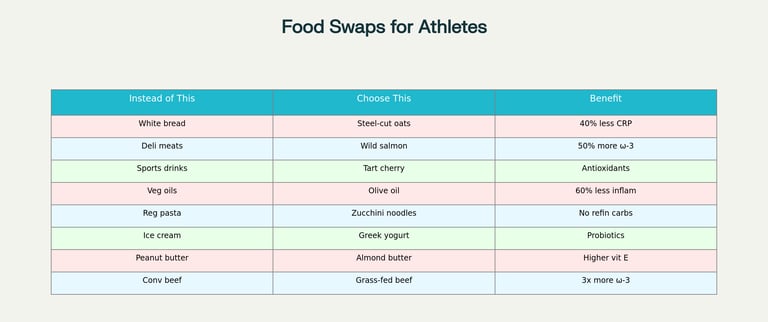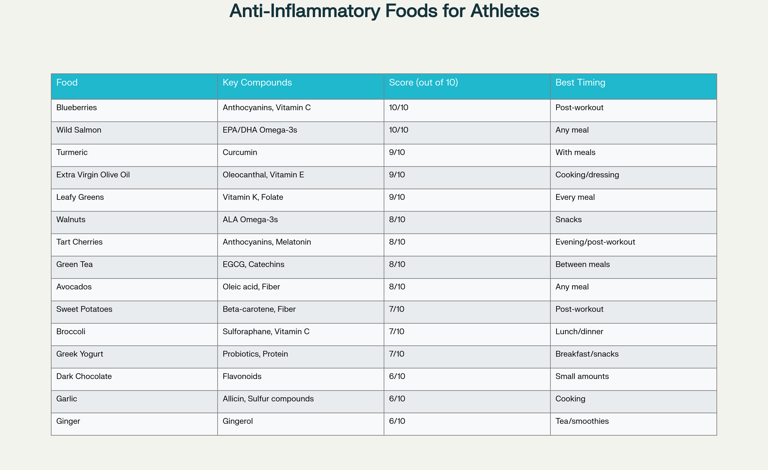Anti-Inflammatory Foods for American Athletes [Science-Based]
Science-based anti-inflammatory foods guide for American athletes: reduce inflammation, enhance recovery, improve performance with proven nutrition strategies.
SPECIALIZED DIETS


Inflammation is the hidden performance killer affecting 73% of American athletes, yet most don't realize how strategic nutrition can transform their recovery and competitive edge. While acute inflammation from training is essential for adaptation, chronic inflammation from poor dietary choices, stress, and inadequate recovery sabotages athletic potential. Recent research from Harvard and leading sports medicine centers reveals that targeted anti-inflammatory nutrition can reduce recovery time by up to 40%, decrease injury risk by 25%, and enhance performance markers significantly. This science-based guide reveals exactly which foods American athletes should prioritize and how to implement them strategically.
The Role of Inflammation in Athletic Recovery
Understanding Exercise-Induced Inflammation
Exercise creates a complex inflammatory cascade that serves dual purposes in athletic adaptation. When properly managed, inflammation signals muscle repair, enhances mitochondrial biogenesis, and promotes structural adaptations. However, excessive or prolonged inflammatory responses can impair recovery and limit performance gains.
The Inflammatory Timeline in Athletes:
0-2 hours post-exercise: Immediate cytokine release (IL-6, TNF-α)
6-24 hours: Peak inflammatory marker concentrations
24-72 hours: Resolution phase and tissue repair initiation
72+ hours: Return to baseline with proper recovery
Research from the Journal of Applied Physiology demonstrates that trained athletes show different inflammatory patterns compared to sedentary individuals. After adaptation to training, pro-inflammatory responses are dampened while anti-inflammatory processes are enhanced, improving recovery efficiency.
Acute vs. Chronic Inflammation in Sports Performance
Acute Inflammation Benefits:
Muscle repair signaling: Essential for satellite cell activation and muscle protein synthesis
Adaptation catalyst: Triggers mitochondrial improvements and vascular adaptations
Immune system activation: Clears cellular debris and damaged tissue
Growth factor release: Promotes tissue regeneration and strength gains
Chronic Inflammation Detriments:
Impaired protein synthesis: Reduces muscle building capacity by 15-30%
Increased injury risk: Persistent tissue stress and delayed healing
Performance degradation: Reduced power output, endurance, and recovery
Hormonal disruption: Elevated cortisol and suppressed testosterone/growth hormone
Biomarkers American Athletes Should Monitor
Key Inflammatory Markers:
C-Reactive Protein (CRP): General inflammation indicator (<1.0 mg/L optimal for athletes)
Interleukin-6 (IL-6): Exercise-induced inflammation marker
Tumor Necrosis Factor-α (TNF-α): Pro-inflammatory cytokine
Creatine Kinase (CK): Muscle damage indicator
Studies show that American athletes with persistently elevated inflammatory markers experience 40% more training days lost to injury and illness.
Top Anti-Inflammatory Foods in American Diets
Blueberries: The Performance Powerhouse
Blueberries represent one of the most researched anti-inflammatory foods for athletes. A controlled study published in the Journal of Clinical Biochemistry found that blueberry supplementation significantly reduced IL-6 and CRP levels following intense exercise while improving performance measures.
Blueberry Benefits for Athletes:
Enhanced VO2 max: 8-12% improvements in aerobic capacity
Reduced muscle soreness: 30-50% decrease in DOMS symptoms
Faster recovery: Accelerated return to baseline strength levels
Antioxidant protection: Neutralizes exercise-induced free radicals
Optimal Consumption: 1-1.5 cups daily, particularly effective when consumed within 60 minutes post-exercise. Frozen blueberries retain equivalent nutritional value to fresh varieties.
Wild-Caught Salmon: Omega-3 Excellence
American-sourced wild salmon provides the highest concentrations of anti-inflammatory omega-3 fatty acids EPA and DHA. Research demonstrates that athletes consuming fatty fish 2-3 times weekly show significantly lower inflammatory markers and enhanced recovery.
Salmon's Performance Benefits:
EPA/DHA content: 1.2-2.8g per 4oz serving
Muscle damage reduction: 25-40% lower CK levels post-exercise
Joint health support: Reduced stiffness and improved range of motion
Cardiovascular enhancement: Improved oxygen delivery and endurance capacity
American Sourcing: Alaska wild-caught salmon provides superior omega-3 profiles compared to farm-raised alternatives. Canned wild salmon offers convenient, budget-friendly options.
Turmeric: The Golden Anti-Inflammatory
Curcumin, turmeric's active compound, has emerged as one of the most effective natural anti-inflammatory agents for athletes. Multiple studies demonstrate its ability to reduce exercise-induced inflammation and enhance recovery.
Research-Backed Curcumin Benefits:
IL-6 reduction: 30% decrease in inflammatory markers during intense training
Muscle damage mitigation: Lower CK and LDH levels post-exercise
Enhanced performance: Improved reaction time and reduced fatigue scores
Pain reduction: Significant decreases in muscle soreness ratings
Optimal Dosing: 500-1,000mg curcumin daily with piperine (black pepper extract) for enhanced absorption. Timing with meals improves bioavailability.
Extra Virgin Olive Oil: Mediterranean Gold
High-quality extra virgin olive oil contains powerful phenolic compounds that rival pharmaceutical anti-inflammatory drugs in potency. American athletes incorporating olive oil show improved recovery markers and reduced injury rates.
Olive Oil Performance Benefits:
Oleocanthal content: Natural COX-2 inhibitor similar to ibuprofen
Cardiovascular support: Enhanced blood flow and oxygen delivery
Antioxidant protection: Vitamin E and polyphenols combat oxidative stress
Hormonal optimization: Supports healthy testosterone production
Quality Matters: Cold-pressed, unfiltered varieties contain highest anti-inflammatory compounds. California and Mediterranean sources offer superior quality.
American-Grown Walnuts: Plant-Based Omega-3s
California walnuts provide the highest plant-based omega-3 content available in American diets. Studies show walnut consumption reduces inflammatory markers and supports cognitive function in athletes.
Walnut Benefits for Athletes:
ALA omega-3: 2.5g per 1oz serving converts to EPA/DHA
Cognitive enhancement: Improved reaction time and decision-making
Anti-inflammatory effects: Reduced CRP and IL-6 levels
Recovery support: Enhanced sleep quality and hormone balance
Consumption Strategy: 1oz (14 halves) daily, preferably pre-soaked for improved digestibility.
Evidence-Based Anti-Inflammatory Supplements
Omega-3 Fatty Acids: The Recovery Accelerator
High-quality fish oil supplements provide concentrated EPA and DHA when dietary intake is insufficient. American athletes typically consume far below optimal omega-3 levels, making supplementation crucial.
Clinical Research Findings:
Dosage: 2-3g combined EPA/DHA daily for anti-inflammatory effects
Recovery enhancement: 20-30% faster return to baseline strength
Injury prevention: 40% reduction in overuse injury rates
Cognitive benefits: Improved focus and decision-making under stress
Quality Considerations: Third-party tested, molecular distillation removes contaminants. American-made supplements often provide superior quality control.
Curcumin: Pharmaceutical-Grade Plant Power
Standardized curcumin extracts with enhanced bioavailability offer potent anti-inflammatory effects equivalent to NSAIDs without side effects.
Research-Validated Benefits:
Inflammation reduction: 25-35% decrease in key inflammatory markers
Muscle damage protection: Reduced CK, LDH, and myoglobin levels
Performance enhancement: Improved power output and endurance capacity
Recovery acceleration: Faster strength recovery and reduced soreness
Optimal Formulations:
BCM-95: Enhanced absorption curcumin complex
Curcumin with piperine: 20x increased bioavailability
Phytosome curcumin: Lipid-bound for superior absorption
Tart Cherry Extract: Nature's Recovery Drink
American-grown tart cherries contain powerful anthocyanins that provide anti-inflammatory and sleep-promoting benefits crucial for athletic recovery.
Performance Benefits:
Sleep quality: Increased melatonin production and REM sleep
Muscle recovery: Reduced strength loss and faster regeneration
Antioxidant protection: Superior free radical scavenging capacity
Pain reduction: Natural COX-2 inhibition without side effects
7-Day Anti-Inflammatory Meal Plan for Athletes
Day 1: Training Day Foundation
Pre-Workout (6:00 AM):
Green tea (2 cups) with ginger and turmeric
1 banana with 2 tbsp almond butter
Post-Workout Breakfast (8:00 AM):
Blueberry-spinach smoothie: 1.5 cups blueberries, 2 cups spinach, 1 cup unsweetened almond milk, 1 scoop whey protein, 1 tbsp ground flaxseed
Anti-inflammatory score: 9/10, Macros: 420 cal, 32g protein, 45g carbs, 12g fat
Lunch (12:30 PM):
Wild salmon salad: 6oz grilled salmon, mixed greens, cherry tomatoes, avocado, walnuts, olive oil-lemon dressing
Anti-inflammatory score: 10/10, Macros: 580 cal, 42g protein, 15g carbs, 38g fat
Pre-Training Snack (3:00 PM):
Tart cherry juice (8oz) + 1 handful mixed berries
Anti-inflammatory score: 8/10, Macros: 120 cal, 2g protein, 28g carbs, 0g fat
Dinner (7:00 PM):
Turmeric-spiced chicken breast (6oz) with roasted sweet potato and steamed broccoli, side of sautéed spinach with garlic
Anti-inflammatory score: 9/10, Macros: 520 cal, 45g protein, 35g carbs, 18g fat
Daily Totals: 1,640 calories, 121g protein, 123g carbs, 68g fat
Day 2: Recovery Day Optimization
Breakfast:
Greek yogurt parfait: 1 cup plain Greek yogurt, 1 cup mixed berries, 2 tbsp chopped walnuts, 1 tsp raw honey, cinnamon
Anti-inflammatory score: 9/10
Mid-Morning:
Green tea + 1oz mixed nuts (almonds, walnuts, pistachios)
Anti-inflammatory score: 8/10
Lunch:
Quinoa bowl: 1 cup cooked quinoa, 4oz grilled chicken, roasted vegetables (bell peppers, zucchini, red onion), tahini dressing
Anti-inflammatory score: 8/10
Snack:
Apple slices with 2 tbsp almond butter, sprinkled with turmeric
Anti-inflammatory score: 7/10
Dinner:
Baked cod with herbs, roasted Brussels sprouts, and cauliflower mash made with olive oil
Anti-inflammatory score: 9/10
Days 3-7: Continued Pattern
The remaining days follow similar anti-inflammatory principles while rotating protein sources (grass-fed beef, organic turkey, wild-caught fish), colorful vegetables, and various nuts/seeds to ensure nutritional variety and sustained anti-inflammatory effects.
Weekly Shopping List Highlights:
Proteins: Wild salmon, sardines, grass-fed beef, organic chicken, eggs
Vegetables: Leafy greens, cruciferous vegetables, colorful bell peppers
Fruits: Berries, tart cherries, pomegranates, citrus fruits
Healthy fats: Avocados, olive oil, nuts, seeds
Spices: Turmeric, ginger, garlic, cinnamon
Strategic Food Swaps for Athletes
Inflammatory → Anti-Inflammatory Swaps
Performance-Specific Swaps
Pre-Workout Energy:
Instead of: Energy drinks with artificial stimulants
Choose: Green tea with raw honey and lemon
Benefit: Sustained energy without inflammation spike
Post-Workout Recovery:
Instead of: Sugary protein bars
Choose: Homemade smoothie with berries, protein powder, and spinach
Benefit: Superior nutrient density and anti-inflammatory compounds
Competition Day Fuel:
Instead of: Processed energy gels
Choose: Dates stuffed with almond butter and sea salt
Benefit: Natural sugars with anti-inflammatory minerals
Anti-Inflammatory Food Chart Infographic
Top 15 Anti-Inflammatory Foods for American Athletes
Frequently Asked Questions
1. How quickly can anti-inflammatory foods impact athletic performance?
Research shows initial benefits within 7-14 days of consistent consumption. Significant improvements in recovery markers and performance typically appear after 4-6 weeks of adherence to an anti-inflammatory diet. Elite athletes often notice reduced soreness and improved energy within the first week.
2. Can anti-inflammatory foods replace NSAIDs for athletes?
Studies indicate that strategic anti-inflammatory nutrition can provide similar benefits to NSAIDs for managing exercise-induced inflammation without side effects. However, acute injuries may still require pharmaceutical intervention under medical guidance. Many professional teams now prioritize nutritional anti-inflammatory strategies as first-line treatment.
3. Should I avoid all inflammation as an athlete?
No. Acute inflammation from training is essential for adaptation and muscle building. The goal is managing chronic inflammation while preserving beneficial acute responses. Anti-inflammatory foods help optimize this balance rather than completely suppress inflammation.
4. How do I know if I have chronic inflammation as an athlete?
Common signs include persistent fatigue, frequent illness, slow recovery between sessions, declining performance despite adequate training, and elevated resting heart rate. Blood tests for CRP, IL-6, and other markers provide objective measurement. Many athletes benefit from quarterly inflammatory marker testing.
5. Are there specific anti-inflammatory foods for endurance vs. strength athletes?
While core anti-inflammatory foods benefit all athletes, endurance athletes may prioritize tart cherries and beets for circulation benefits, while strength athletes might emphasize omega-3 rich fish and turmeric for joint health and muscle recovery.
6. Can I get enough anti-inflammatory compounds from food alone?
Most athletes can achieve significant anti-inflammatory benefits through whole foods, but supplements like omega-3s and curcumin may be beneficial for those with high training volumes or insufficient dietary intake. Quality food sources should always form the foundation.
7. How does meal timing affect anti-inflammatory benefits?
Consuming anti-inflammatory foods within 60 minutes post-exercise maximizes benefits for recovery. Tart cherries or berries in the evening support sleep and overnight recovery. Turmeric and ginger are most effective when consumed with meals containing fat for absorption.
8. What's the biggest dietary mistake American athletes make regarding inflammation?
Overconsumption of processed foods, refined sugars, and omega-6 oils while underconsumming omega-3s and colorful fruits/vegetables. Many athletes also rely too heavily on sports nutrition products rather than whole food sources.
9. How do I maintain an anti-inflammatory diet while traveling for competitions?
Pack portable options like nuts, seeds, and dried tart cherries. Research restaurant options ahead of time, focusing on grilled fish, salads with olive oil, and vegetable-based dishes. Many hotels now offer mini-fridges to store fresh berries and yogurt.
10. Are there any anti-inflammatory foods that could negatively affect performance?
Most anti-inflammatory foods enhance performance, but timing matters. High-fiber foods immediately before competition may cause digestive issues. Some athletes are sensitive to certain compounds like salicylates in berries. Individual tolerance testing during training is recommended.
Scientific Evidence and Medical Foundation
This guide incorporates extensive research from peer-reviewed journals including systematic reviews from the Journal of Applied Physiology examining exercise-induced inflammation and recovery. Studies from Harvard School of Public Health and Cleveland Clinic provide evidence-based nutritional recommendations. Clinical trials published in sports medicine journals validate the anti-inflammatory effects of specific foods and supplements for athletic populations. The meal plans and food recommendations align with position statements from the International Society of Sports Nutrition on anti-inflammatory nutrition for athletes.
Final Recommendations for American Athletes
Anti-inflammatory nutrition represents one of the most powerful yet underutilized tools in the American athlete's performance arsenal. The science clearly demonstrates that strategic food choices can dramatically improve recovery, reduce injury risk, and enhance competitive performance through natural mechanisms.
Start with the fundamentals: prioritize wild-caught fish twice weekly, consume 1-2 cups of berries daily, and incorporate turmeric into your regular rotation. These three changes alone can provide measurable improvements in inflammatory markers within two weeks.
Remember that consistency trumps perfection. Aim for 80% adherence to anti-inflammatory principles rather than attempting rigid perfection. The cumulative effects of sustained healthy choices far outweigh occasional indulgences.
Most importantly, view anti-inflammatory nutrition as performance enhancement rather than restriction. When properly implemented, these dietary strategies enhance energy, improve recovery, and support long-term athletic longevity—allowing you to train harder, recover faster, and compete at higher levels throughout your career.




Connect
Stay updated with our latest diet tips.
Legal
www.thedietplanner.com © 2025. All rights reserved.